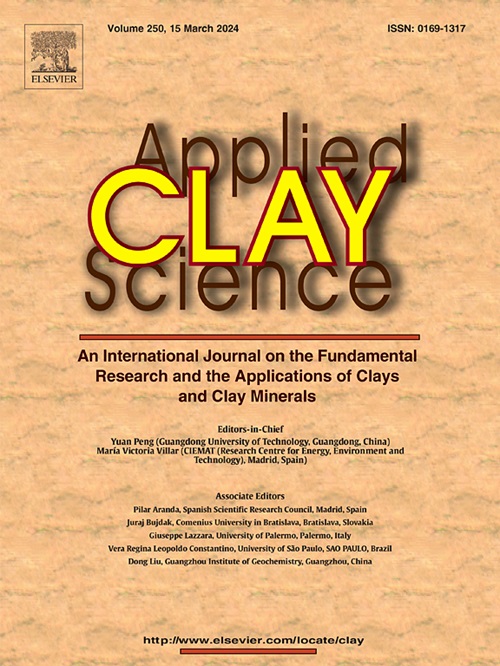Sonochemically improved regeneration of mechanically amorphized Ca2Cr-layered double hydroxides – Synthesis, characterization and photocatalytic lidocaine decomposition
IF 5.3
2区 地球科学
Q2 CHEMISTRY, PHYSICAL
引用次数: 0
Abstract
Our aim was to extend the structure recovery method previously seen for mechanochemically amorphized Ca2Fe-layered double hydroxides (LDH) to additional LDHs and to further improve it by utilizing ultrasonic irradiation. Work commenced with the synthesis of Ca2Cr-LDH, under the developed optimal conditions of unusually high alkali concentration (9 M NaOH) and mild heating (50 °C). Comparing ultrasonic treatment with mechanical mixing, sonication was able to recover the original structure twice as fast, reduce the direct optical band gaps of LDHs by larger extent, while the surface CrVI content decreased by nearly 20 %. Without base addition, Ca2M-hydrocalumites (MIII: Al, Sc, V, Cr, Fe, Ga, In) was used as sacrificial templates in lidocaine photomineralization by forming active MIII hydroxides and oxide particles. LDH-derived Cr(OH)3 proved to be a robust and reusable catalyst, with efficiencies ahead of many semiconductors such as SnO2, BiOBr, WO3, SrTiO3 and ZnO. At pH 12, dissolution of Ca2Cr-LDHs was inhibited, so that the catalytic effects of pre-milling and structural restoration could be studied. Performance of Ca2Cr-LDHs nearly doubled after grinding, while a small increase was observed for Mg2Cr- and a decrease for Zn2Cr-LDHs. However, with appropriate structural recovery, activity of all LDHs was enhanced compared to the initial or ground solids. Benefits of ultrasonic recovery in catalysis over mechanical stirring have also been demonstrated and highlighted key aspects of the efficiency of structure recovery in the significantly different hydrocalumite−hydrotalcite systems.
求助全文
约1分钟内获得全文
求助全文
来源期刊

Applied Clay Science
地学-矿物学
CiteScore
10.30
自引率
10.70%
发文量
289
审稿时长
39 days
期刊介绍:
Applied Clay Science aims to be an international journal attracting high quality scientific papers on clays and clay minerals, including research papers, reviews, and technical notes. The journal covers typical subjects of Fundamental and Applied Clay Science such as:
• Synthesis and purification
• Structural, crystallographic and mineralogical properties of clays and clay minerals
• Thermal properties of clays and clay minerals
• Physico-chemical properties including i) surface and interface properties; ii) thermodynamic properties; iii) mechanical properties
• Interaction with water, with polar and apolar molecules
• Colloidal properties and rheology
• Adsorption, Intercalation, Ionic exchange
• Genesis and deposits of clay minerals
• Geology and geochemistry of clays
• Modification of clays and clay minerals properties by thermal and physical treatments
• Modification by chemical treatments with organic and inorganic molecules(organoclays, pillared clays)
• Modification by biological microorganisms. etc...
 求助内容:
求助内容: 应助结果提醒方式:
应助结果提醒方式:


